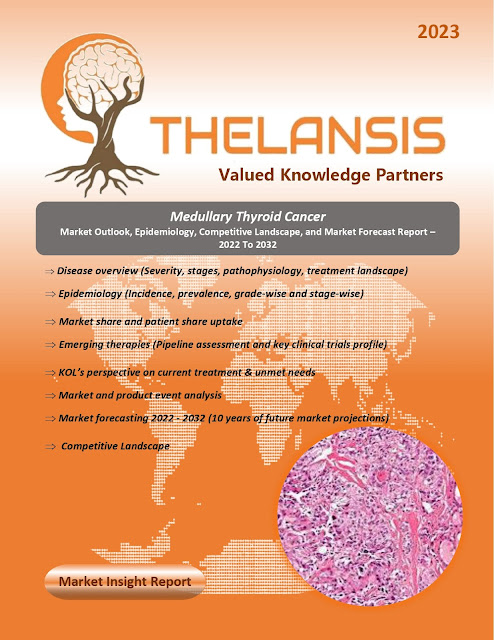Medullary Thyroid Cancer (MTC) – Market Outlook, Epidemiology, Competitive Landscape, and Market Forecast Report – 2022 To 2032
Medullary Thyroid Cancer (MTC) originates from the parafollicular cells, also known as C cells, of the thyroid gland, which produces calcitonin. This tumor is derived from neural crest cells and is characterized by elevated calcitonin levels. About 75-80% of medullary thyroid cancers are sporadic, while the remaining cases are familial and occur in multiple endocrine neoplasias (MEN) 2A, MEN 2B, and familial medullary thyroid cancer (FMTC). The development of MTC can be attributed to RET mutations in the neural crest tissue of the thyroid gland. Germline mutations are associated with MEN2 and FMTC medullary thyroid cancers, while 40-50% of sporadic medullary thyroid cancers have acquired RET mutations. Medullary thyroid cancer associated with multiple MEN syndromes is often multicentric and bilateral, whereas sporadic medullary thyroid cancer is usually unilateral. These tumors typically involve the upper portions of both lobes of the thyroid gland since C cells are predominantly located in the upper poles of the gland. Paraneoplastic syndromes, such as Cushing syndrome and carcinoid syndrome, can also occur in MTC, producing hormones such as corticotropin, serotonin, prostaglandins, and melanin. The five-year survival rate for stages 1 to 3 of medullary thyroid cancer is 93%, whereas, for stage 4, it is only 28%. Surgical resection is the primary treatment for medullary thyroid carcinoma, as this cancer does not respond to conventional chemotherapy or radioactive iodine (RAI).
·
Thyroid cancer represents 2.3% of new
malignancies occurring annually in the United States, with an annual incidence
of approximately 14.6 per 100,000. Of those thyroid cancer diagnoses, 2% to 3%
are medullary thyroid carcinoma (MTC), translating into 1080-1620 new diagnoses
annually.
Thelansis’s “Medullary Thyroid Cancer
(MTC) Market Outlook, Epidemiology, Competitive Landscape, and Market Forecast
Report – 2021 To 2032" covers disease overview, epidemiology, drug
utilization, prescription share analysis, competitive landscape, clinical
practice, regulatory landscape, patient share, market uptake, market forecast,
and key market insights under the potential Medullary Thyroid Cancer (MTC)
treatment modalities options for eight major markets (USA, Germany, France,
Italy, Spain, UK, Japan, and China).
KOLs insights
of Medullary Thyroid Cancer (MTC) across 8 MM market from the centre of
Excellence/ Public/ Private hospitals participated in the study. Insights
around current treatment landscape, epidemiology, clinical characteristics,
future treatment paradigm, and Unmet needs.
Medullary Thyroid Cancer (MTC) Market Forecast Patient
Based Forecast Model (MS. Excel Based Automated Dashboard), which Data Inputs
with sourcing, Market Event, and Product Event, Country specific Forecast
Model, Market uptake and patient share uptake, Attribute Analysis, Analog
Analysis, Disease burden, and pricing scenario, Summary, and Insights.
Thelansis Competitive Intelligence (CI) practice
has been established based on a deep understanding of the pharma/biotech
business environment to provide an optimized support system to all levels of
the decision-making process. It enables business leaders in forward-thinking
and proactive decision-making. Thelansis supports scientific and commercial
teams in seamless CI support by creating an AI/ ML-based technology-driven
platform that manages the data flow from primary and secondary sources.




Comments
Post a Comment